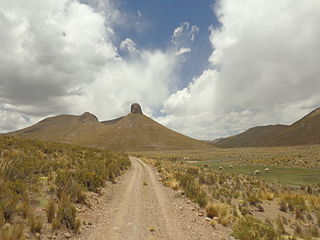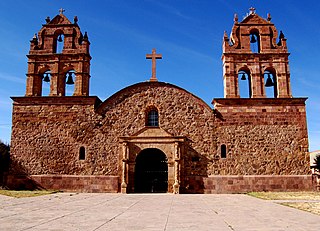
Ingavi is a province in the La Paz Department in Bolivia. This is where the Battle of Ingavi occurred on November 18, 1841 and where the World Heritage Site of Tiwanaku is situated.

José Manuel Pando is a province in the La Paz Department in Bolivia. It was founded on April 22, 1986 during the presidency of Víctor Paz Estenssoro. The province was named after José Manuel Pando (1848-1917) who was the president of Bolivia from 1899 till 1904. Its capital is Santiago de Machaca.

Jesús de Machaca Municipality is the sixth municipal section of the Ingavi Province in the La Paz Department in Bolivia. It was created by Law No. 2351 on May 7, 2002, during the presidency of Jorge Quiroga Ramírez. Its seat is Jesús de Machaca.

Jach'a Jawira which downstream is named Japha Jawira is a Bolivian river east of Lake Titicaca in the La Paz Department, Los Andes Province, Batallas Municipality and in the Omasuyos Province, Achacachi Municipality. Its waters flow to Lake Titicaca via the Qiqa Jawira.
The Jach'a Jawira is a river in the La Paz Department of Bolivia, south of Wiñaymarka, the southern branch of Lake Titicaca. It is a tributary of the Desaguadero River.

Wila Qullu is a mountain in the Andes in Bolivia, about 5,144 metres (16,877 ft) high. It is located in the Oruro Department, Challapata Province, Challapata Municipality. Wila Qullu is situated south of Jach'a River and north of Nacional Route 1. It lies north-west of the mountain Wila Quta which reaches the same height.
Qullpa Jawira is a Bolivian river east of Poopó Lake in the Oruro Department, Challapata Province, Challapata Municipality, and in the Santiago de Huari Municipality. It originates near Ch'iyar Jaqhi northeast of Jatun Wila Qullu and flows in a north-eastern direction. South of Wila Qullu it meets the T'ula Pallqa River whose source, the Jach'a Juqhu River, is considered the origin of the Pillku Mayu.
Jach'a Jawira is a Bolivian river north of Coipasa Lake in the Oruro Department. Coming from the Waylla Marka range northwest of Poopó Lake the river flows in a south-western direction along the village of Belén de Choquecota in the Nor Carangas Province towards the Carangas Province. In the Choquecota Municipality, southwest of Choquecota, it empties into the Barras River which ends in Coipasa Lake.
Jach'a Jawira is a Bolivian river east of Poopó Lake in the Potosí Department, Rafael Bustillo Province, Chuqi Uta Municipality.
Jach'a Jawira is a Bolivian river east of Poopó Lake in the Potosí Department, Rafael Bustillo Province, Uncía Municipality.

Urqu Jawira is a Bolivian river in the La Paz Department, Aroma Province, Calamarca Municipality.

Qutapata is a 5,288-metre-high (17,349 ft) mountain in the Cordillera Real in the Bolivian Andes. It is situated in the La Paz Department, Murillo Province, La Paz Municipality, near the border with the Sud Yungas Province, Yanacachi Municipality. Qutapata lies south-west of the mountain Sirk'i Qullu, west of the mountain Jathi Qullu and south of the lake Sirk'i Quta.

Wawachani is a 5,136-metre-high (16,850 ft) mountain in the Andes in Bolivia. It is sistuated in the Oruro Department, Challapata Province, Challapata Municipality. It lies north-west of the mountains Wichhu Qullu and Wila Qullu and east of Thuru.

Wila Qullu is a mountain in the Andes in Bolivia, about 5,060 metres (16,601 ft) high. It is situated in the Oruro Department, Challapata Province, Challapata Municipality, Challapata Canton. Wila Qullu lies south-east of the mountains Thuru and Wawachani and north-west of Wichhu Qullu. It is situated north of Chunkara Lake.

Wila Willk'i is a 4,630-metre-high (15,190 ft) mountain in the Bolivian Andes. It is located in the La Paz Department, Loayza Province, Malla Municipality. Wila Willk'i is situated northwest of Malla and a mountain named Malla Qullu.

Jach'a Qullu is a 4,390-metre-high (14,403 ft) mountain in the Bolivian Andes. It is located in the La Paz Department, Loayza Province, Malla Municipality. Jach'a Qullu is situated south-west of the mountains Wila Willk'i, Malla Qullu and Janq'u Qalani (Jankho Khalani). It lies west of Malla. The river Jach'a K'uchu Jawira flows along the northern slopes of Jach'a Qullu.
Malla Jawira is a river in the La Paz Department in Bolivia. It is a right tributary of the Luribay River whose waters flow to the La Paz River.
Jach'a Jawira which later is named Q'ara Qullu and Waña Jawira is a Bolivian river in the La Paz Department and in the Oruro Department. Its waters flow towards Uru Uru Lake.













